|
|
|
Sort Order |
|
|
|
Items / Page
|
|
|
|
|
|
|
| Srl | Item |
| 1 |
ID:
171669
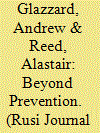

|
|
|
|
|
| Summary/Abstract |
The rise to prominence of Daesh and its expert exploitation of extremist propaganda has brought in to focus the role of strategic communications in counterterrorism (CT) and countering violent extremism policy. Nonetheless, strategic communications tends to be discussed largely in relation to counter-recruitment and counter-radicalisation. Using the UK’s CT strategy as a case study, Andrew Glazzard and Alastair Reed argue that strategic communications has a far wider application in CT.
|
|
|
|
|
|
|
|
|
|
|
|
|
|
|
|
| 2 |
ID:
171664
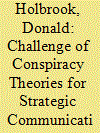

|
|
|
|
|
| Summary/Abstract |
Donald Holbrook highlights the role conspiracy theories play in relation to state and non-state strategic communications efforts that are hostile to Western security interests. Not only is their use and acceptance prevalent, but conspiracy theories also represent powerful rhetorical tools to justify indiscriminate or mass-scale aggression since they link shared grievances with alleged and purported networks of perpetrators, whose intent, secrecy, agency and connectedness are taken for granted.
|
|
|
|
|
|
|
|
|
|
|
|
|
|
|
|
| 3 |
ID:
171667


|
|
|
|
|
| Summary/Abstract |
Many prevention and countering of violent extremism experts place too much emphasis on the radicalising power of online mass distributed messaging by violent extremist groups. Instead, Nafees Hamid argues that radicalisation takes place in a social ecology within which the messaging of terrorist groups plays only a small role. This article shows that people are resistant to mass persuasion and that certain environments are more conducive to the spread of extremist messaging. Small-group dynamics are useful to explain the spread of ideas and that altering these dynamics can provide a buffer against some ideas while enabling others.
|
|
|
|
|
|
|
|
|
|
|
|
|
|
|
|
| 4 |
ID:
171666
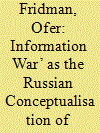

|
|
|
|
|
| Summary/Abstract |
The Kremlin employs a type of ‘strategic communications’, which, according to the Russian conceptualisation of information war, is a combination of military and non-military means intended to influence the information-psychological space of a targeted audience. Ofer Fridman argues that the Kremlin’s employment of economic counter-sanctions (non-military means) and its intervention in Syria (military means) demonstrate the Kremlin’s capability to participate in information war – the Russian counterpart of Western strategic communications.
|
|
|
|
|
|
|
|
|
|
|
|
|
|
|
|
| 5 |
ID:
171673
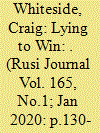

|
|
|
|
|
| Summary/Abstract |
This article analyses the Islamic State media department’s involvement in deceptive influence efforts. Relying on an extensive database of the department’s products from its origins to the present (Tawhid wal-Jihad, Al-Qa’ida in Iraq, the Mujahidin Shura Council, the Islamic State of Iraq and ISIS), Craig Whiteside identifies situations when decisions are made to involve the media in deception efforts, and why. He finds that the Islamic State used deception infrequently and carefully, usually in a defensive manner, while carefully balancing the need for credible and truthful information activities outside its deception efforts.
|
|
|
|
|
|
|
|
|
|
|
|
|
|
|
|
| 6 |
ID:
171670
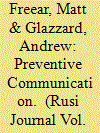

|
|
|
|
|
| Summary/Abstract |
This article is in two parts. The first is theoretical and sets out the basis for why communications in the field of countering violent extremism (CVE) may be more effective if they are participative rather than strategic and rhetorical. The second provides emerging lessons from a pilot CVE intervention, ‘Preventive Communication’, which was undertaken with the involvement of the authors as part of two larger CVE projects in Kenya between 2016 and the present day.
|
|
|
|
|
|
|
|
|
|
|
|
|
|
|
|
| 7 |
ID:
171668


|
|
|
|
|
| Summary/Abstract |
In the military, the concept of atmospherics is deployed to capture the environment within which operations take place, the receptivity of local populations, and how militaries are perceived. Yet, it is insufficiently developed within wider security debates. Claire Yorke asks what the concept means within national security policy and how it should it be defined, measured, and applied. Focusing on counterterrorism policy, she examines how reading the mood of society and community atmospherics can shape better policy. She contends that a more deliberate and conscious reading of the emotional, social and political landscape can inform strategic communications and contribute to more citizen-centric engagement.
|
|
|
|
|
|
|
|
|
|
|
|
|
|
|
|
| 8 |
ID:
171665


|
|
|
|
|
| Summary/Abstract |
This work was supported by a research award from Facebook as part of its ‘Content Policy Research on Social Media Platforms’ research project. The views and conclusions contained in this document are those of the author and should not be interpreted as representing the policies, either expressed or implied, of Facebook. In this article, Charlie Winter challenges the way in which the word ‘propaganda’ is used in contemporary discourse around war and terrorism. He considers the case of the Islamic State, using it to demonstrate that the term – as it is conventionally understood – is an inadequate tool when it comes to describing the full range of tactical and strategic approaches to communication that are employed by insurgents today. If anything, he contends, ‘propaganda’ refers to an entire information ecosystem in which different media are geared towards different tasks.
|
|
|
|
|
|
|
|
|
|
|
|
|
|
|
|
| 9 |
ID:
171671
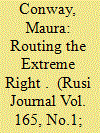

|
|
|
|
|
| Summary/Abstract |
Between 2014 and 2017, the Islamic State maintained vibrant communities on a range of social media platforms. Due to aggressive account and content takedown policies by the major platforms, these visible communities are now almost non-existent. Following the March 2019 Christchurch attack, the question as to why major platforms cannot rout the extreme right in the same way has repeatedly arisen. In this article, Maura Conway explores why this is not as straightforward as it may seem.
|
|
|
|
|
|
|
|
|
|
|
|
|
|
|
|
| 10 |
ID:
171662
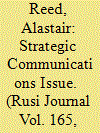

|
|
|
|
|
| Summary/Abstract |
The weaponisation of communications by state and non-actors has emerged as one of the most pressing security concerns facing Western democracies. Over the past decade, the communication threat from extremist organisations has been transformed by the rise of the Islamic State (IS). While the use of propaganda is nothing new, IS has employed strategic communications more successfully than earlier extremist organisations, and effectively exploited the emergence of new technologies to disseminate its message directly. But the reach of this new approach to communication goes far beyond IS, with the threat from other extremist movements such as far-right and nationalist groups becoming increasingly challenging. This step-change is, of course, not limited to non-state actors. States have also sought to exploit the influencing power of new technology to conduct disinformation campaigns, such as Russian interference in the US elections. Thus, liberal democracies face multiple threats from malign influencing activities, and the nature and perceptions of these threats have been transformed by the emergence of new technology, in particular social media. As a result, strategic communications needs to become an increasing priority, and while the threats are diverse, they do not exist in isolation, and our response needs to be both strategic and comprehensive.
|
|
|
|
|
|
|
|
|
|
|
|
|
|
|
|
| 11 |
ID:
171663
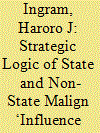

|
|
|
|
|
| Summary/Abstract |
Malign ‘influence activities’ conducted by state and non-state adversaries are one of the most pressing security challenges facing democracies globally. Haroro J Ingram offers a framework through which to understand the overarching strategic logic of a diverse spectrum of propaganda and disinformation threats targeting democratic populations. He argues that these activities seek to erode social trust, trust in authorities/expertise and trust in democracy, driving psycho-social and strategic effects that may contribute to the weakening of democratic institutions and processes. He concludes by identifying three strategic policy pillars that could be used to develop a more assertive posture for the protection and projection of democracy.
|
|
|
|
|
|
|
|
|
|
|
|
|
|
|
|
| 12 |
ID:
171672


|
|
|
|
|
| Summary/Abstract |
Racist flyers and posters have a long history in the US. In recent years, these ephemeral pieces of propaganda have been coordinated and amplified through the use of the internet and social media. In a vicious circle, racist flyers are propagated online, then printed by activists and distributed offline. After distribution, photos and other documentation of the flyer drops are then posted online in order to amplify their message and inspire further drops. J M Berger, Kateira Aryaeinejad and Seán Looney examine the patterns of racist flyer content and distribution in 2018, including the coordination of posting activity online and the content of flyers. The article draws on a dataset of flyer drops created by the Anti-Defamation League, which was enriched by the authors for content and analysis of online/offline connections.
|
|
|
|
|
|
|
|
|
|
|
|
|
|
|
|
|
|
|
|
|